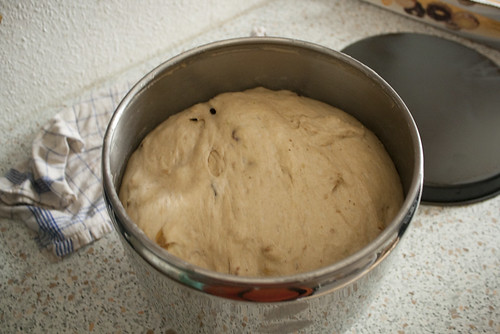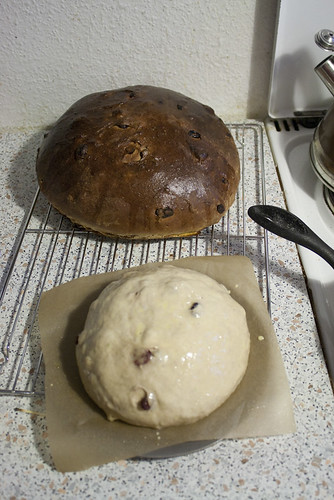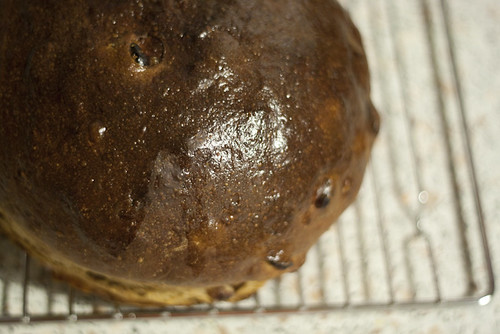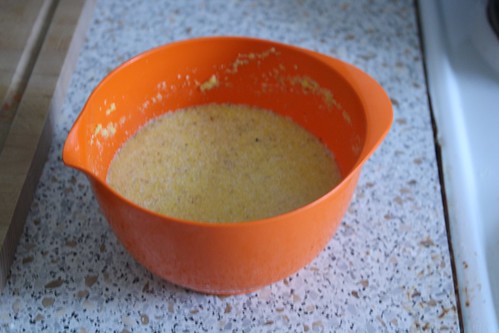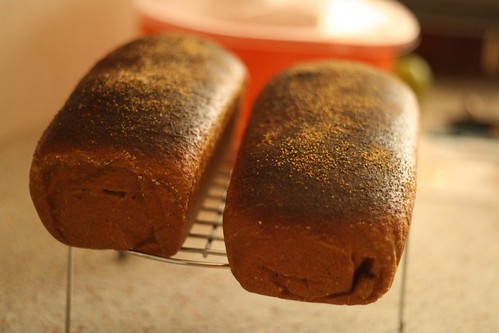Perhaps it was because my first introduction to Bagels was a Peanut Butter and Chocolate Chip Bagel from Goldstein's in Old Town Pasadena. Or because my second introduction was the quite amazing Baguel Gourmet in Providence. By then, I had a wide range of bagel types that the NY ones just seemed to lack something. New York did have great knishes though. Yum.
So it was with some trepidation that I approached making Bagels for the Bread Baker's Apprentice Challenge. Bagels are hard to find here in Berlin, and there are a few places with good bagels that tend to charge about 3€ per bagel, so I have learned to live without. Plus, the last time I made Bagels they were a dismal failure. All thick and gross.
This time, however, I came prepared. I had high-gluten flour, procured from my last visit to the Mehlstübchen, a specialty flour store a five minute bike ride away. Yes, I said a specialty flour store. They apparently have more than 100 types of flour, but I have only spotted about thirty or so. I usually get Type 812 and Type 1050 flour here, but I asked if they had any high-gluten flour, and this is what I got:

I prepared the poolish on Wednesday, just after my order of a Lochblech came in. The Lochblech is like a sheet pan with hundreds of little holes in it. I thought it would help air circulation, but I don't know how effective it really is.

Yes, that is a brotpisker, procured from the King Arthur Flour Catalogue more than 11 years ago! Which means I have been making bread for at least 13 years now. Off and on, though more off than on in the last eight.
Oh, wait a minute. I had forgotten that I had two batches of bread going on from Monday!

The red bowl has the Bagel Poolish, the big orange one in the middle has Pain a l'ancienne (my favorite bread from the book) and the one on the bottom has Pâte fermentée for a batch of French Bread. The Bagel Poolish is marked with the time it was prepared, and the bottom one is marked with the time the other two came out of the fridge. I'm a huge fan of marking my plastic wrap to keep track of things.
Here's the poolish after two hours. I will spare you the torturous details about the work on the French Bread.he

Being a homebrewer, I just happened to have some Malt Extract on hand. Though the bag actually looks small in the picture, it is a 3L bag half full with Light Dried Malt Extract, weighing about a 1,2KG. From this bag, I took 10 grams.

The malt reminded me that I have some homebrew in the fridge. Unfortunately, only a 75cL bottle which I normally share.

The glass is the last one I have left from a Crate and Barrel purchase. I only brought one over, foolishly thinking I could get good pints anywhere.

The beer is a British Bitter, with very light carbonation to mimic Cask Ale. It is delicious beyond belief except that it is a bit too bitter, the hops getting in the way of the malt balance. It's also too dark, but at 4,5%, it is too weak to be an Extra Special Bitter. I guess Best Bitter would be a better description of the style.
I put the malt, salt, yeast and the rest of the flour into the DLX. After about 10 minutes, it formed The Fabled DLX Donut. Which means the dough formed a ring inside the machine.

Unfortunately, even after 20 minutes in the machine on medium the thing refused to windowpane. I even kneaded it for 5 minutes by hand, but it was a no go.

The dough was sliced into rolls weighing approximately 128 grams each.

I did not take any pictures of the bagel forming, as I was trying to get the french bread into the oven. The Pain a l'ancienne was put back into the fridge for another day (today early morning). I ended up going to bed at 1 in the morning.
Because the bagels were taking up two whole shelves of our fridge, I woke up early. I fired up the ol' stove and filled the brewing kettle with about a gallon of water. This kettle is the only thing in my kitchen with only imperial measurements. It holds a maximum of 20 quarts of fluid, but is usually full with only 12 quarts of wort at any one time.

Despite the pot being big enough to boil five bagels at any one time, I ended up doing them in batches of three, as flipping over a bagel and trying not to disturb the other four was nearly impossible.
I baked them in two batches because the oven is pretty small and I wanted good results. So, after the first batch went into the oven, the second one came out of the fridge and was boiled.
The results were superb.

I made six plain, three poppy seed, and three with sesame seeds. The reason being that I totally forgot about the toppings until after the first batch was in the oven.

I immediately had a half spread with Sirop de Liège. Here's a cut away to show off the crumb as well as the sirop.

Although the crust was chewy, the inside was soft, so they were not my ideal bagels. Also, because the bagels drove me crazy and pushed the limits of both my patience and my small kitchen, I decided I wasn't going to give them away like I normally would. I got a bunch of freezer bags and put them into one of the freezer drawers for later.
Up next is Brioche. And I already have the pans for it!



